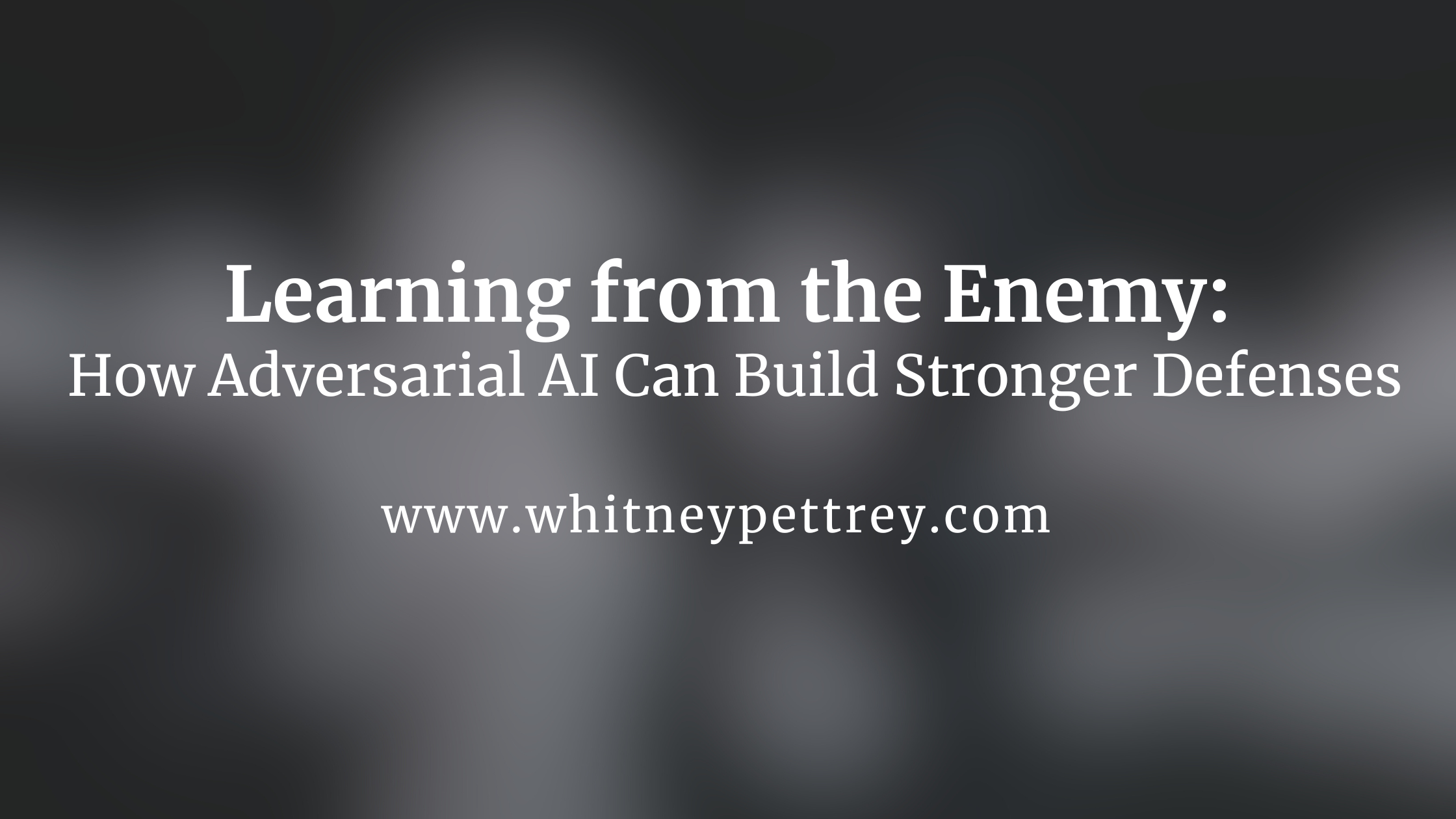Artificial Intelligence (AI) has become a game-changer in cybersecurity, enabling organizations to anticipate threats, automate responses, and analyze vast amounts of data at unprecedented speeds. But what if we shifted our focus? What if, instead of only defending against threats, we used AI to think like an adversary—to simulate, strategize, and outmaneuver attackers before they strike?
Adversarial AI, when harnessed strategically, provides a unique lens into the mindset of malicious actors. By studying potential exploits, vulnerabilities, and attack methodologies, organizations can build defenses that are not only reactive but proactive and resilient. This approach does more than strengthen cybersecurity; it transforms the entire paradigm of digital defense and raises critical questions about the future of security leadership.
Adversarial AI: A Weapon in the Hands of Leaders
Adversarial AI does not merely simulate attacks; it redefines the battlefield. It can serve as a weapon for defenders to anticipate and counter malicious actors but also represents a risk when used by attackers to find and exploit vulnerabilities. The duality of adversarial AI demands a nuanced understanding of its capabilities and implications.
- Exploitation Pathways: Advanced adversarial models can map how attackers breach defenses, providing a clear picture of critical vulnerabilities.
- Evasion Tactics: Machine learning can reveal sophisticated methods to bypass even the most advanced detection systems, offering valuable insight for fortifying defenses.
- Weaponization Risks: Attackers can utilize adversarial AI to generate polymorphic malware or automate phishing campaigns, outpacing traditional defenses.
Rather than waiting for adversaries to exploit vulnerabilities, adversarial AI empowers organizations to think several steps ahead, hardening their systems against even the most advanced persistent threats (APTs). However, this power comes with responsibility and ethical complexity.
Pushing Boundaries: Leveraging Adversarial AI for Resilience
To truly benefit from adversarial AI, organizations must move beyond traditional applications and embrace its full potential as a transformative tool. Here’s how:
- Simulating Multi-Vector Threats: Use AI to model complex, multi-vector attacks that mimic the behavior of sophisticated adversaries. These simulations expose gaps in defenses that traditional testing might overlook.Case Study: A critical infrastructure provider deployed adversarial AI to simulate simultaneous attacks on physical and digital systems. The results revealed dependencies between network access points and operational systems, allowing for targeted reinforcement.
- Creating Dynamic Deception Ecosystems: Adversarial AI can create hyper-realistic honeypots and decoy networks that actively mislead attackers. These systems gather actionable intelligence while diverting attention from critical assets.
- Weaponizing Defense: Imagine defenses that adapt dynamically during an attack. Adversarial AI can identify and neutralize malicious patterns in real-time, turning every attack into an opportunity to strengthen the system.
- Augmenting Threat Intelligence: Adversarial AI can automate the discovery of emerging attack patterns across global threat landscapes, predicting trends before they materialize into threats.
- Enhancing Decision-Making: Use adversarial AI as part of incident response frameworks to simulate potential outcomes of different strategies, ensuring that leadership makes informed decisions during critical events.
The Dark Edge: Ethical and Strategic Considerations
Leveraging adversarial AI forces cybersecurity leaders to confront uncomfortable truths about the ethical lines they are willing to cross. This technology is as dangerous as it is powerful, and its misuse could have catastrophic consequences. As organizations adopt adversarial AI, they must grapple with these questions:
- Controlled Chaos or Unchecked Power? How do we ensure adversarial AI remains a tool for defense rather than a weapon for destruction?
- Transparency vs. Obfuscation: Should organizations disclose their use of adversarial AI to foster trust, or keep it concealed to maintain strategic advantage?
- Ethical Gray Areas: Is it ethical to use adversarial AI to simulate attacks on third-party systems for vulnerability assessments?
Balancing Risks and Rewards
Organizations must establish strict protocols and governance to navigate these challenges:
- Conduct all adversarial AI operations in isolated environments to prevent unintended consequences.
- Regularly audit AI systems for alignment with ethical standards and strategic goals.
- Foster collaboration between cybersecurity leaders, ethicists, and policymakers to create a shared framework for responsible use.
Next-Generation Applications: Shaping the Future
Adversarial AI offers untapped potential that extends far beyond current use cases. By looking to the future, we can envision applications that redefine resilience and reshape the cybersecurity landscape.
Quantum-Resistant Cryptography
As quantum computing evolves, adversarial AI can simulate post-quantum attack scenarios, enabling organizations to develop cryptographic protocols that withstand future computational power.
Counterintelligence Operations
Adversarial AI can uncover hidden patterns in data exfiltration attempts, bolstering defenses against insider threats and advanced espionage campaigns.
Autonomous Red Teaming
Imagine autonomous Red Teams that continuously test and adapt defenses in real-time. These systems could create an ongoing feedback loop, driving innovation and resilience at unprecedented speeds.
Global Cyber Diplomacy
Adversarial AI can simulate the potential fallout of cyberattacks on a geopolitical scale, helping policymakers craft strategies to avoid escalation and foster international cooperation in cybersecurity norms.
Revolutionizing Leadership Through Adversarial AI
Adversarial AI isn’t just a tool—it’s a philosophy. Cybersecurity leaders who embrace this mindset challenge the status quo, push boundaries, and redefine what it means to be resilient. These leaders:
- Act Boldly: They are unafraid to explore the darker edges of technology to protect their organizations.
- Think Strategically: By adopting an attacker’s perspective, they anticipate threats and design systems that cannot be outmaneuvered.
- Inspire Innovation: They foster cultures that embrace curiosity and challenge conventional approaches.
A Call to Action: Redefine the Battlefield
The future of cybersecurity demands leaders who are willing to think differently. By embracing adversarial AI, we can transform every threat into an opportunity, every vulnerability into a lesson, and every attack into a catalyst for innovation. This is more than a shift in tools—it’s a shift in mindset.
Now is the time to act. Leverage adversarial AI to push boundaries, redefine resilience, and lead the charge into a future where foresight and innovation are our strongest weapons. Together, let’s shape a digital battlefield where strength lies not in defense but in the power to outthink, outmaneuver, and outlast any adversary.
